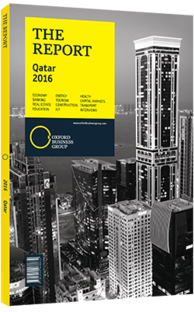Petrochemicals increases its contribution to Qatar's GDP
Perhaps unsurprisingly, given the country’s substantial oil and gas operations, Qatar’s downstream petrochemicals sector forms a key pillar of its industrial base – and, like the upstream industry, it has maintained robust output despite depressed global oil prices. Led by Qatar Petrochemical Company (QAPCO), an offshoot of state-owned oil company Qatar Petroleum (QP) through the latter’s industrial subsidiary, Industries Qatar (IQ), the sector made some $9.3bn in revenues from domestic operations in 2014, according to a report released in November 2015 by the Gulf Petrochemicals and Chemicals Association (GPCA). This was the equivalent of some 44% of value added by local manufacturing that year – higher than in Saudi Arabia (34%) and Kuwait (24%), though below that in Oman (59%) – yielding a GDP contribution of 4.4%, up from 4.2% in 2013 and the largest of any manufacturing segment. In a regional context, this performance put Qatar’s sector at about a 9% share of the GCC’s 2014 output of 136m tonnes, which was worth some $88bn, down slightly from $89.4bn in 2013, due to falling export prices.
Sector Advantages
One cause of Qatar’s out-sized share of the Gulf petrochemicals market is the low cost of inputs. Like many government-linked businesses in Qatar such as its electricity and water producers, QAPCO receives hydrocarbons feedstock at favourable rates from its parent company, QP, boosting the margins it earns on products like low-density polyethylene (LDPE), a common plastic used in machine mouldings and electric cables.
Thus, even while hydrocarbons output fell by 1.3% in 2014, the sector was able to increase its contribution to total manufacturing by 1.4 percentage points. Qatar’s petrochemicals sector has also benefitted from the region’s growing construction industry, which furnishes steady buyers for LDPE by-products.
Capex Projects
The halving of oil prices in the second half of 2014 resulted in a decline of the industrial segment’s share of GDP by over 15% during 2015, affecting capital investments in new facilities. As prices fell further during 2015, two IQ petrochemicals projects were eventually shelved, which represented a blow to the industry.
The first, a $6bn plant in Al Sejeel that was put on hold in September 2014, was to be completed in 2018 with an annual production capacity of some 1.4m tonnes of ethylene, 2m tonnes of polyethylene, 760,000 tonnes of polypropylene and 83,000 of butadiene. The second project, mothballed four months later in January 2015, was a $6.5bn plant to be built in Al Karaana as an 80:20 joint venture between QP and Shell.
Looking Forward
Despite the ongoing volatility in oil markets, a number of reasons for optimism remain. “The long-term scenario is more positive,” said Abdulwahab Al Sadoun, the GPCA’s secretary-general. In late 2015, he told local press that GCC petrochemicals output was forecast to grow by 6% a year over the next half-decade, reaching some 190m tonnes in 2020.
The slowdown in China, the prospect of Iran’s economy opening and the more cautious mood as the global economy adjusts to lower commodities prices, he explained, has spurred Gulf producers to become “more agile, collaborative and innovative”, since they are price takers rather than setters.
“The drive into higher-value products, such as speciality and performance chemicals, is gaining momentum,” said Al Sadoun, “and is expected to act as a catalyst for an even stronger growth of the GCC petrochemical industry in the years to come.” Indeed, according to India-based TechSci Research, Qatar’s construction chemicals market alone – a segment whose products are used in a wide range of building operations – is forecast to grow by 13% per year in 2015-20 as infrastructure projects accelerate to meet targets ahead of the 2022 FIFA World Cup.
You have reached the limit of premium articles you can view for free.
Choose from the options below to purchase print or digital editions of our Reports. You can also purchase a website subscription giving you unlimited access to all of our Reports online for 12 months.
If you have already purchased this Report or have a website subscription, please login to continue.

